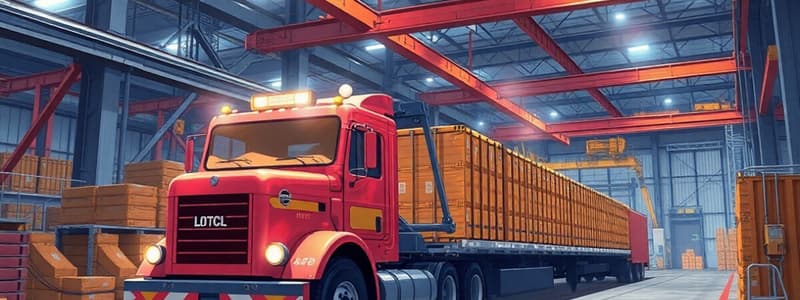Podcast
Questions and Answers
What is the primary benefit of using mechanized materials-handling equipment?
What is the primary benefit of using mechanized materials-handling equipment?
- More physical labor required
- Higher efficiency and productivity at lower cost (correct)
- Higher rate of workplace injuries
- Increased material damage
Which of the following is a principle of effective materials handling?
Which of the following is a principle of effective materials handling?
- Avoid mechanical equipment altogether
- Use the shortest routes for movement (correct)
- Utilize individual unit movement
- Move materials as frequently as possible
What does effective materials handling contribute to in a manufacturing setting?
What does effective materials handling contribute to in a manufacturing setting?
- Increased manufacturing cycle time
- Fewer injuries and lower costs (correct)
- Higher product damage rates
- Reduced storage capacity
What should be avoided to enhance materials handling processes?
What should be avoided to enhance materials handling processes?
Which factor is NOT important when selecting materials handling equipment?
Which factor is NOT important when selecting materials handling equipment?
What is the average ratio of material moved to product produced in industry?
What is the average ratio of material moved to product produced in industry?
What impact does material handling have on product cost?
What impact does material handling have on product cost?
Which of the following is a consideration for improving in-plant layout through materials handling?
Which of the following is a consideration for improving in-plant layout through materials handling?
Flashcards
Materials Handling
Materials Handling
The art and science of moving, packing, and storing materials of any form.
Purpose of Material Handling
Purpose of Material Handling
To lower costs, reduce cycle times, control material flow, improve conditions, maintain quality, increase storage, and boost productivity.
Minimize Material Movement
Minimize Material Movement
Moving materials as little as possible, using efficient routes and equipment.
Batching Material Movement
Batching Material Movement
Signup and view all the flashcards
Equipment Design
Equipment Design
Signup and view all the flashcards
Importance of Gravity
Importance of Gravity
Signup and view all the flashcards
Avoid Rehandling
Avoid Rehandling
Signup and view all the flashcards
Material Handling Equipment Maintenance
Material Handling Equipment Maintenance
Signup and view all the flashcards
Study Notes
Materials Handling Overview
- Materials handling is performed in every department, warehouse, office, and facility within a company.
- It's a task done by virtually every worker, either as a primary duty or as part of other regular work.
- This includes manual labor and mechanical assistance.
- On average, industry transports approximately 45 tons of materials for every ton of product created.
- Mechanized materials handling equipment increases efficiency and productivity while keeping costs lower in many industries.
- Mechanized handling, while improving efficiency, can introduce new safety hazards. However, the overall impact, neglecting the efficiency benefits, frequently results in fewer injuries, lower workers' compensation costs, and a more productive workforce.
Definition of Materials Handling
- Materials handling encompasses the art and science of moving, packing, and storing substances in any form.
Importance of Material Handling
- Production control is essential in scheduling production.
- Material handling adds value to the cost of producing a product.
- Material handling enhances the effectiveness of in-plant layouts, which lowers costs.
Objectives of Materials Handling
- Lower per-unit material handling costs.
- Reduce manufacturing cycle times.
- Improve material flow control.
- Enhance working conditions.
- Improve product quality by preventing damage.
- Increase storage capacity.
- Increase productivity at lower manufacturing cost.
Material Handling Principles
- Minimize material movement.
- Utilize shortest routes and mechanical equipment to reduce moving time.
- Move materials in bulk whenever possible, rather than individually.
- Design material handling equipment for maximum effectiveness.
- Leverage gravity wherever possible.
- Avoid rehandling and backtracking materials.
- Regularly maintain material handling equipment.
Factors Affecting Material Handling Equipment Selection
- Production problems
- Human factors (capabilities of the workforce, employee safety)
- Availability of materials handling equipment
Production Problem Factors
- Volume of production.
- Plant and building layout
- Type of material(s) to be handled
Types of Material Handling Systems
- Equipment-oriented systems: Conveyors, tractor transfer systems, forklifts, industrial trucks, underground systems
- Material-oriented systems: Unit handling systems, bulk handling systems, liquid handling systems
- Methods-oriented systems: Manual systems, automated systems, job shop handling systems, mass production systems
- Function-oriented systems: Transportation systems, conveying systems, transferring systems, elevating systems
Types of Materials Handling Equipment
- Conveyors: Gravity or powered devices used for moving loads over fixed paths (Belt, Chain, Roller, Pneumatic)
- Cranes, Elevators, and Hoists: Overhead devices for moving varying loads between points
- Industrial Trucks: Electric, diesel, gasoline or gas-powered, such as forklifts and pallet trucks.
- Auxiliary Equipment: Devices or attachments for improving handling equipment effectiveness and versatility (Skid Boxes, Expendable Pallets)
Studying That Suits You
Use AI to generate personalized quizzes and flashcards to suit your learning preferences.




